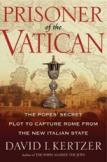State-ly Intrigue
In light of the present worldwide prestige of the papacy, it comes as a shock to realize that less than a century and a quarter ago an anticlerical mob tried to interrupt Pope Pius IX’s funeral procession, determined to throw the pope’s corpse into the Tiber. And it seems like ancient history to recall that Pius IX and the four popes who followed him, from 1870 to 1929, all styled themselves prisoner of the Vatican and refused to leave its confines in protest against the new Italian state that had taken from them the Papal States and the city of Rome. All of them, Pius IX, Leo XIII, Pius X, Benedict XV and Pius XI (until he signed the Lateran treaties) denounced in decreasingly hostile terms the new Italian state. They endorsed Pius IX’s argument that the anticlerical state had stolen what he called the Patrimony of St. Peter, and they hoped that their denunciations, their disapprovals and their forbidding of Catholics to participate in national elections (up to 1919) would bring the Italian state down.
But in fact, as David Kertzer demonstrates in this lively narrative, the popes had no material force at hand and could rely only on their spiritual suasion of Catholics, both in Italy and abroad, to achieve their aim of restoring the papal territories to their control. One way of doing this was to apply diplomatic pressure on foreign powers, to play the game of diplomacy, pitting one state against another, hoping to use the allegiance of the Catholics in those states (France, Germany and Austria) and their fear of one another in the increasingly dangerous world of alliances and imperialistic ventures that eventually erupted into World War I.
Author of the rightfully acclaimed The Kidnapping of Edgardo Mortara, the story of the shameful abduction of a young Jewish boy by Pius IX, and the polemically anti-papal The Popes Against the Jews, Kertzer in this work concentrates on the pontificates of Pius IX (1846-78) and Leo XIII (1878-1903). He uses a wide array of sources, including abundant documentation from his research in the Vatican archives. His narrative is filled with telling anecdotes and colorful descriptions of the various characters involved in the struggle, including the leaders of Italian unification, the Italian monarchs, the anticlerical Italian politicians, foreign diplomats and both intransigent and accommodating cardinals and bishopsnot all clerics supported the popes in their aims.
The pontificate of Pius IX is well known. Hailed as the liberal pope at his accession in 1846, he turned intransigent after the 1848 revolution in Rome forced him into exile, and he returned to Rome with a decades-long condemnation of what he termed the modern world. He lost the Papal States to the forces of Italian unification but was protected in Rome by the troops of French Emperor Napoleon III until those troops had to be pulled out to defend France against the Prussians in 1870, just after the First Vatican Council had proclaimed papal infallibility. Pius hoped that the European Catholics would pressure their governments to restore Rome to him. Roman anticlericals, free now from papal control, agitated against the Pope. Just as eagerly, papal supporters rallied to his defense, intensifying the continuing clerical/anticlerical conflict.
What is not as well known are the papal politics of Pius’s successor, Leo XIII. On this Kertzer’s narrative sheds new light. Appearing as a more progressive pontiff, Leo seemed at first to signal a change from Pius’s intransigent policies, but then he began to vacillate between Vatican die-hard opponents of any concessions to the Italian state and bishops who wanted compromise, so that their faithful, as well as themselves, could become Italian patriots. When he selected as his secretary of state the intransigent Mariano Rampolla, it was a sign that the die-hards had won. Rampolla and the nuncios then began to play the diplomatic game to win concessions. Their chief tactic was to threaten to have the pope go into exile as a means of pressuring foreign governments to back the restoration of the papal territories. Germany, France and Austria all feared that the Catholics in their domains would force their governments to war with Italy to prevent the ignominy of a papal exile. At the same time, each of the European powers saw the opportunity of taking advantage of an Italian state weakened by conflict over such a papal exile. But it was not a consistent game. The shifting fortunes of the various nations with one another, in the rivalry of international politics and of alliances, led the states to change policies from time to time. And the papal diplomats were not above considering conspiring with Italian republicans to overthrow the Savoy monarchy and establish an Italian federal republic, in which the papal lands could once again be restored.
With the death of Leo in 1903, the papal diplomatic initiative was pushed into the background as the new pope, Pius X, became more concerned with doctrinal matters, and his successors, Benedict XV and Pius XI, gave up the hope of a restoration of papal temporal power, finally acknowledging the loss of papal lands in the Lateran Pacts of 1929. The increasing growth of papal prestige after 1929 became proof that the Italian anticlericals were right: the papacy did not need its former territories to be independent; and if Rome is no longer under papal political control, it is, if nothing else, the cultural center of the Catholic, and hence, papal, world.
This article also appeared in print, under the headline “State-ly Intrigue,” in the November 8, 2004, issue.








